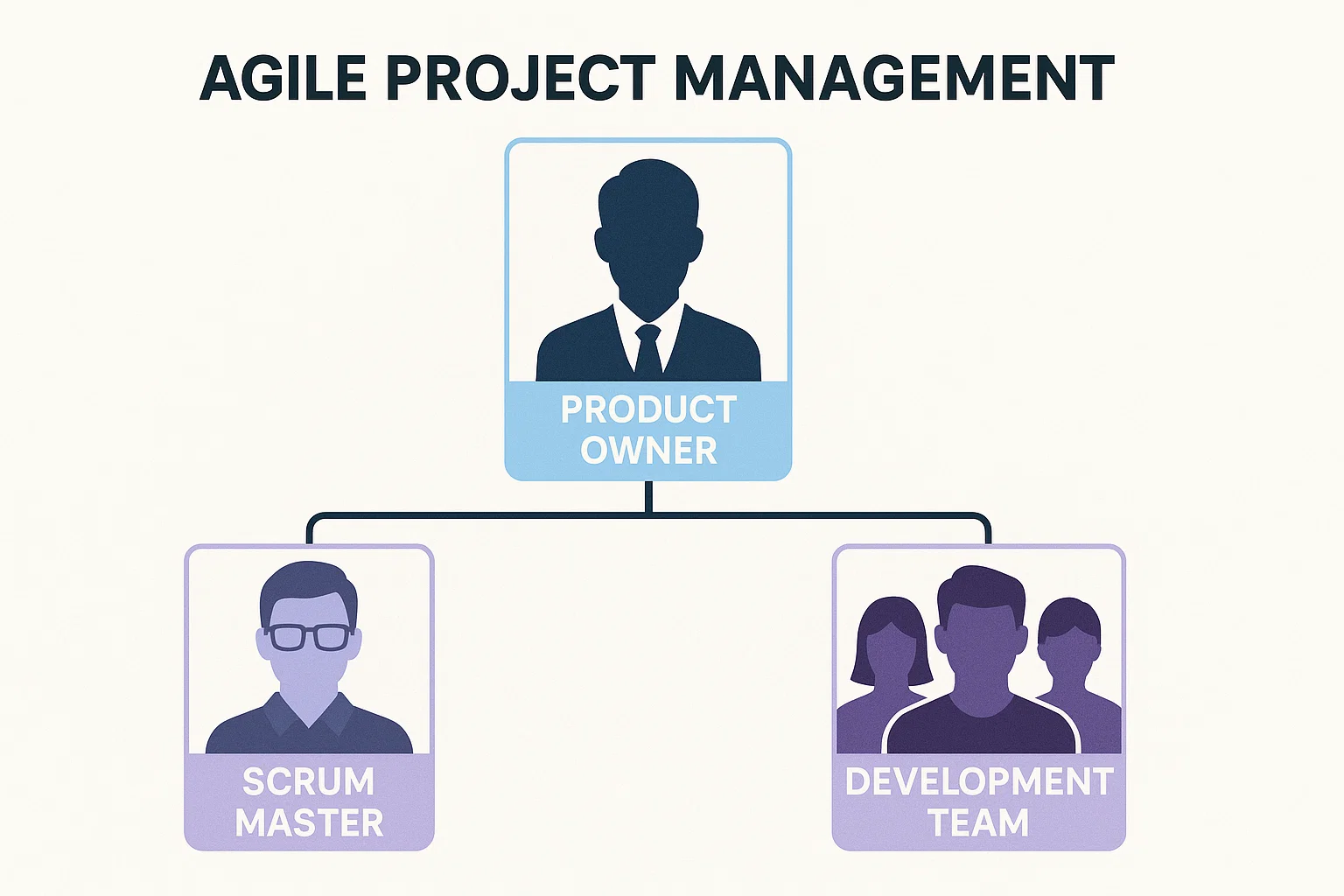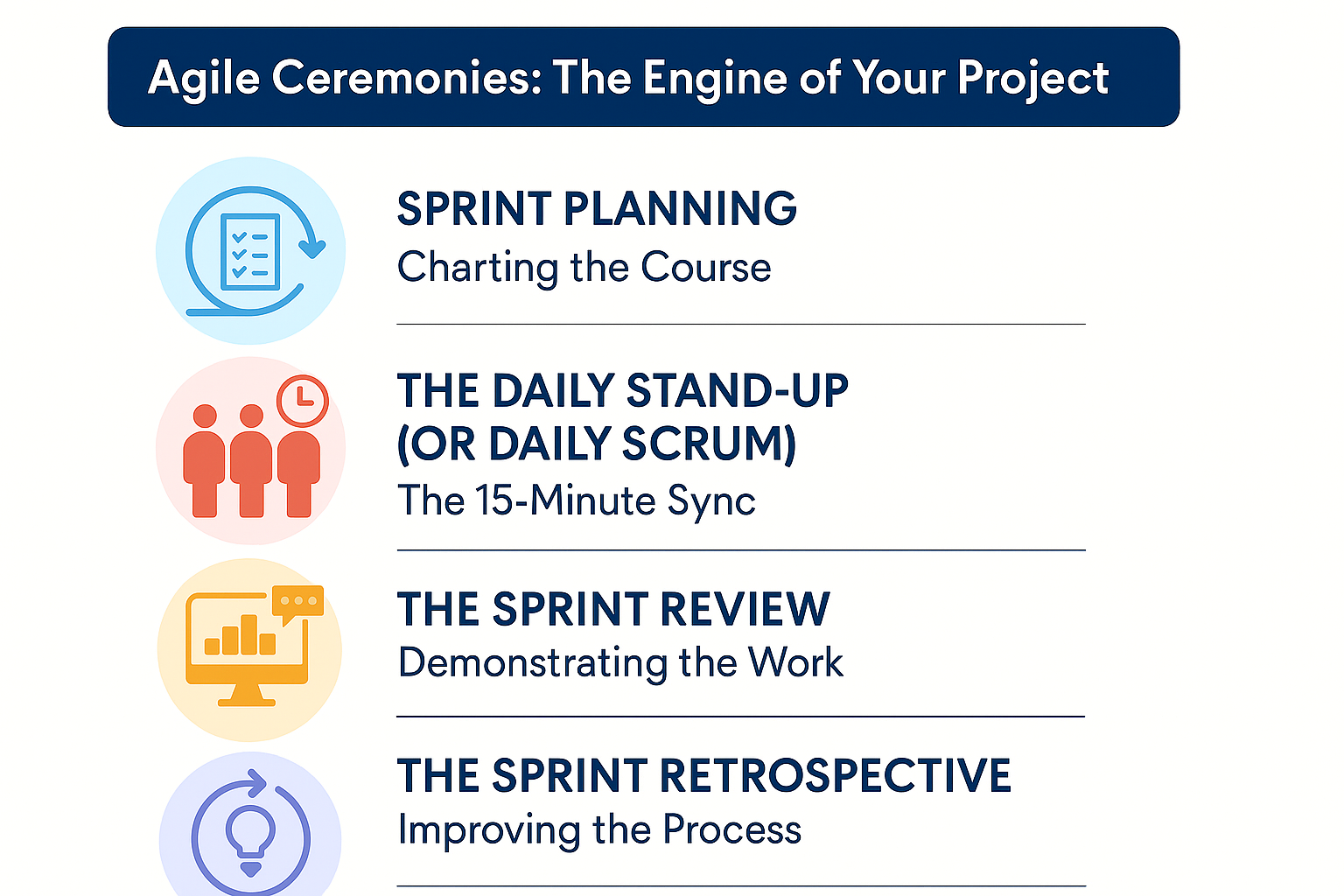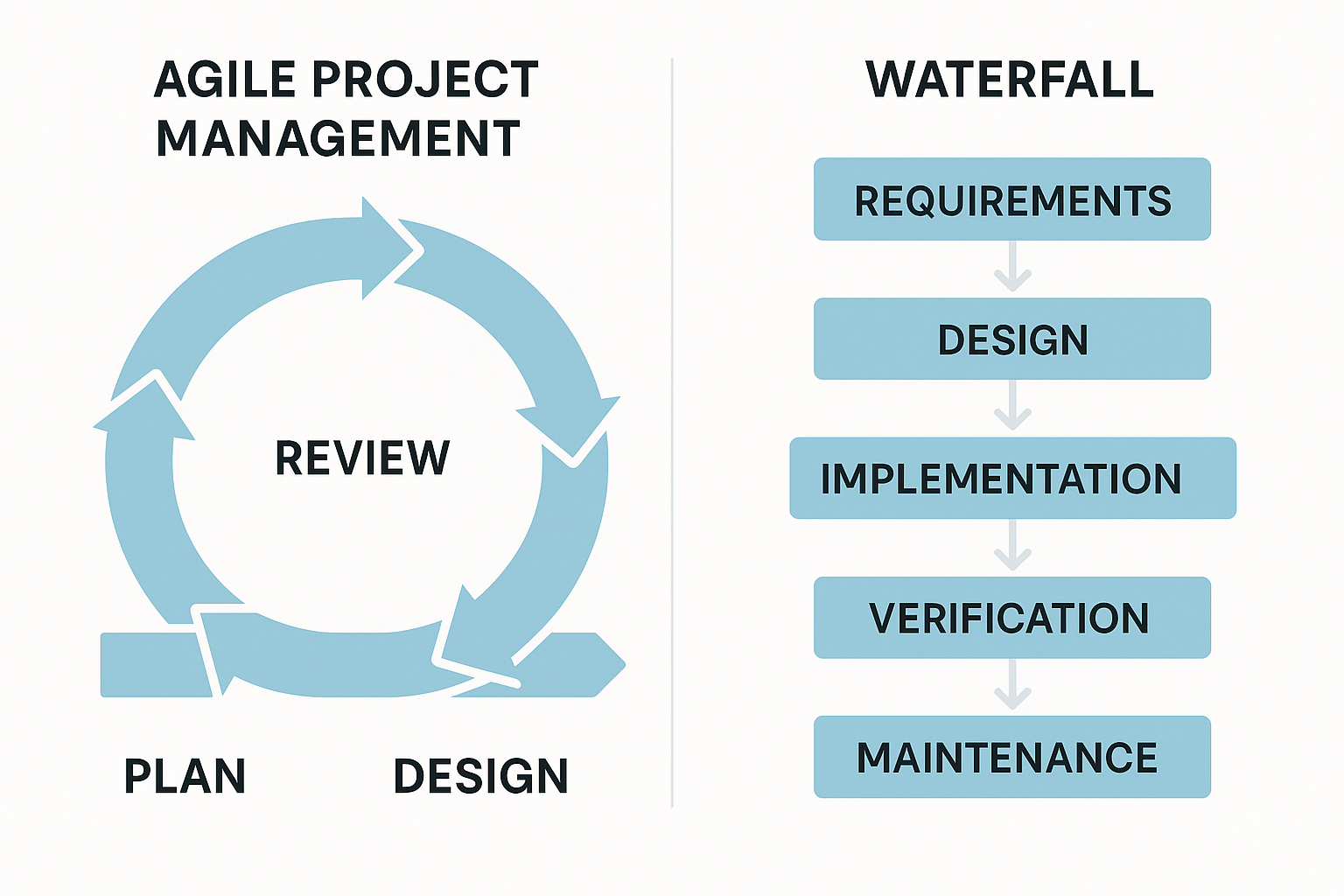Your team is weeks into a major project when a key stakeholder requests a significant change. With a traditional approach, this is a crisis that involves derailing the schedule and going back to the drawing board. But what if you could embrace that change without sacrificing momentum? This is the core promise of agile project management. If you’re looking for a more flexible, responsive, and modern way to deliver value, you’ve come to the right place. The fundamental question of what is project management is evolving, and Agile is at the heart of that evolution.
This guide is different. It’s an unbiased, in-depth resource designed to give you a complete understanding of the Agile mindset. We’ll cut through the jargon to explain the basics, break down the core principles, and give you a practical framework for getting started.
This guide is different. It’s an unbiased, in-depth resource designed to give you a complete understanding of the Agile mindset. We’ll cut through the jargon to explain the basics, break down the core principles, and give you a practical framework for getting started.
Key Takeaways
- Agile is an iterative approach, not a linear one. It breaks down large projects into small, manageable cycles called sprints, allowing for continuous adaptation.
- It’s a mindset, not just a process. Agile is guided by 12 core principles, including customer satisfaction, welcoming change, and empowering teams.
- Scrum and Kanban are frameworks, not the same as Agile. They are structured methods for implementing the Agile philosophy. Choosing the right one is a critical first step.
- Success depends on people. Agile defines specific roles like the Product Owner and Scrum Master to improve focus, remove blockers, and maximize value.
What Is Agile Project Management?
At its core, agile project management is an iterative approach to completing projects. Instead of a single, long-term plan executed in a linear sequence (like the Waterfall method), an Agile project is broken down into small, shippable increments. Teams work in short cycles called “sprints” or “iterations,” allowing for continuous feedback, adaptation, and improvement throughout the entire project lifecycle.
So, what is an agile project? It’s any project that benefits from this iterative approach—one where requirements are likely to evolve, speed-to-market is critical, and customer collaboration is key.
So, what is an agile project? It’s any project that benefits from this iterative approach—one where requirements are likely to evolve, speed-to-market is critical, and customer collaboration is key.
Agile Project Management Examples in Action
While born in software development, agile management is now used everywhere:- Marketing Team: A marketing team launches a new campaign in two-week sprints. Sprint 1 is for initial ad creative and landing pages. Sprint 2 uses real performance data to refine messaging and A/B test new visuals.
- Website Development: A team builds a new e-commerce site. Instead of launching a “perfect” site after six months, they launch a Minimum Viable Product (MVP) with core functionality in six weeks, then add new features and improvements in subsequent sprints based on real user feedback.
The Basics of Agile: The 5 Key Concepts of Agile Methodology
To truly understand Agile, you need to grasp its core philosophy. These are the five key concepts that drive every decision in agile project management.
- Iterative Development: Projects progress in a series of short, repeated cycles. Each cycle (or “sprint”) produces a small, working piece of the larger project, which is then tested and reviewed.
- Value-Driven Delivery: The highest priority is to deliver value to the customer, early and often. The team constantly asks, “What is the most valuable thing we can work on right now?”
- Empowered, Self-Organizing Teams: Agile trusts teams to manage their own work. Instead of a top-down command structure, teams are given the autonomy and responsibility to decide how they will accomplish their goals.
- Continuous Feedback & Collaboration: Feedback is not a one-time event; it’s a constant loop. Teams collaborate daily with each other and frequently with stakeholders and customers to ensure the project stays on the right track.
- Adaptability to Change: Agile doesn’t just tolerate change; it expects it. The iterative nature of agile project management means that changing requirements are seen as opportunities to create a better product, not as disruptions to a rigid plan.
The 12 Principles of Agile Project Management: The Guiding Rules
These are the foundational rules from the original Agile Manifesto that guide the implementation of any agile project management framework. Understanding them is key to adopting the Agile mindset.
- Customer Satisfaction: Our highest priority is to satisfy the customer through early and continuous delivery of valuable software.
- Welcome Changing Requirements: Harness change for the customer’s competitive advantage, even late in development.
- Deliver Working Software Frequently: Deliver value in weeks rather than months, creating shorter feedback loops.
- Business and Developers Must Work Together: Break down silos between technical and business teams to ensure daily collaboration.
- Build Projects Around Motivated Individuals: Give the team the environment and support they need, and trust them to get the job done.
- The Most Efficient Method of Communication is Face-to-Face: Prioritize direct conversation to convey information and build alignment.
- Working Software is the Primary Measure of Progress: The ultimate metric of success is a product that works, not just completed documentation.
- Agile Processes Promote Sustainable Development: The team should be able to maintain a constant, sustainable pace indefinitely, avoiding burnout.
- Continuous Attention to Technical Excellence: Good design and clean code enhance a team’s ability to remain agile.
- Simplicity is Essential: The art of maximizing the amount of work not done is a core skill. Focus on what’s truly needed.
- The Best Architectures Emerge from Self-Organizing Teams: Trust that empowered teams will make the best design and implementation decisions.
- Regularly Reflect and Adjust: The team periodically reflects on how to become more effective, then tunes and adjusts its behavior accordingly.
How to Choose Your First Agile Framework: Scrum vs. Kanban in Practice
Agile is a philosophy, but you need a framework to put it into practice. Most teams begin their agile project management journey by choosing between Scrum and Kanban. While many guides define them, few help you make the critical choice of where to start.
Choose Scrum if…
- Scrum: A highly structured framework built around fixed-length iterations called sprints. It has defined roles and events.
- Kanban: A more flexible framework focused on visualizing and optimizing a continuous flow of work.
Choose Scrum if…
- You are building a new product or project from scratch.
- Your project has a level of complexity that benefits from being broken down into predictable, two-week chunks of work.
- Your team can commit to a sprint goal and protect that time from outside interruptions.
- You need a framework that forces regular opportunities for planning, review, and improvement.
- Your work is a continuous flow of incoming tasks with shifting priorities (e.g., IT support, content marketing, maintenance).
- You need to visualize your entire workflow to identify and eliminate bottlenecks. The idea of fixed sprints feels too rigid for your team’s process.
- Your primary goal is to improve efficiency and the speed of delivery for an existing process.
The Agile Team: A Deep Dive into Roles and Responsibilities

An effective agile project management implementation is less about the tools and more about the people. Unlike traditional project management, Agile defines specific roles with clear responsibilities designed to maximize collaboration and accountability.
Expert Take: “A common mistake is assigning Agile roles to people with old titles without changing their mindset. Your ‘Project Manager’ is not your ‘Scrum Master.’ A Scrum Master serves the team by removing blockers, while a traditional PM often directs the team by assigning tasks. Understanding this shift is critical for success.”
Expert Take: “A common mistake is assigning Agile roles to people with old titles without changing their mindset. Your ‘Project Manager’ is not your ‘Scrum Master.’ A Scrum Master serves the team by removing blockers, while a traditional PM often directs the team by assigning tasks. Understanding this shift is critical for success.”
The Product Owner: The Voice of the Customer
The Product Owner is the single point of accountability for the product’s success. They don’t manage the team; they manage the product backlog and represent the interests of all stakeholders, especially the customer.- Key Responsibilities:
- Owns and Manages the Product Backlog: Creates, maintains, and prioritizes the master list of all work that needs to be done.
- Defines User Stories: Clearly articulates what needs to be built from a user’s perspective.
- Maximizes Value: Ensures the development team is always working on the features that will deliver the most value to the customer and the business.
- Is the Final Arbiter: Has the final say on whether a delivered feature meets the acceptance criteria.
The Scrum Master / Agile Coach: The Servant Leader
The Scrum Master is not a manager in the traditional sense. They are a “servant leader” whose primary job is to remove impediments, facilitate the Agile process, and coach the team on Agile principles.- Key Responsibilities:
- Facilitates Agile Ceremonies: Leads meetings like Sprint Planning and Retrospectives, ensuring they are productive and stay on track.
- Removes Impediments: Identifies and resolves any blockers—technical, organizational, or interpersonal—that are slowing the team down.
- Protects the Team: Shields the team from outside distractions and interruptions so they can focus on the sprint goal.
- Coaches Agile Principles: Helps the team and the broader organization understand and adopt the Agile mindset.
The Development Team: The Builders
This is the cross-functional group of individuals who do the actual work of building the product increment. In software, this includes developers, testers, and designers. In marketing, it could include copywriters, graphic designers, and ad specialists.- Key Characteristics:
- Self-Organizing: The team decides how they will accomplish the work selected for a sprint.
- Cross-Functional: The team possesses all the skills necessary to turn a backlog item into a finished, shippable increment of work.
- Accountable as a Unit: Success or failure is a team outcome, not an individual one.
A Closer Look at Agile Ceremonies: The Engine of Your Project

Agile ceremonies (or “events” in Scrum) are the structured meetings that provide the rhythm for an Agile project. They are not status meetings; they are carefully designed events that create a feedback loop for both the product and the process.
Sprint Planning: Charting the Course
- Purpose: To decide what work can be done in the upcoming sprint and how it will be done.
- Process: The Product Owner presents the highest-priority items from the product backlog. The Development Team asks questions to clarify requirements and then forecasts how much of that work they can complete in the sprint. The outcome is a shared Sprint Goal and a Sprint Backlog.
The Daily Stand-up (or Daily Scrum): The 15-Minute Sync
- Purpose: A quick, daily meeting for the Development Team to coordinate their work and identify any blockers.
- Process: Each team member briefly answers three questions:
- What did I do yesterday to help the team meet the sprint goal?
- What will I do today to help the team meet the sprint goal?
- Do I see any impediments that prevent me or the team from meeting the sprint goal?
The Sprint Review: Demonstrating the Work
- Purpose: To showcase the work that was completed during the sprint and gather feedback from stakeholders.
- Process: The team presents a live demo of the working product increment. Stakeholders ask questions and provide feedback, which the Product Owner can use to update the product backlog for future sprints. This is a crucial feedback loop on the product.
The Sprint Retrospective: Improving the Process
- Purpose: A private meeting for the Scrum Team (Product Owner, Scrum Master, and Development Team) to reflect on the sprint and identify ways to improve their process.
- Process: The team discusses what went well, what could be improved, and what they will commit to changing in the next sprint. This is a vital feedback loop on the process and is the engine of continuous improvement in agile management.
The Best Tools for Agile Project Management
While the Agile mindset is more important than any specific tool, the right software can dramatically streamline your workflow. The best tool depends on your chosen framework.
- For Scrum Teams: Look for tools with strong features for sprint planning, backlog grooming, and Agile reporting. Industry standards like Jira and highly customizable platforms like ClickUp are excellent choices.
- For Kanban Teams: Your primary need is a powerful, flexible, and visually intuitive board. Trello is famous for its simplicity, while Asana offers more robust features for managing complex Kanban workflows.
- For All-in-One / Hybrid Solutions: If your teams use a mix of methodologies or you want a single platform for your entire organization, look for flexible solutions. Tools like Monday.com and Karya Keeper can be adapted to support Scrum, Kanban, and other hybrid workflows.
Measuring Success: Essential Agile Metrics and KPIs
While agile project management values working software over comprehensive documentation, it still relies on data to guide decision-making and improve predictability. These are a few of the most common metrics used.
Velocity
- What it is: The average amount of work a team completes during a sprint, typically measured in story points.
- How it’s used: After a few sprints, a team’s average velocity becomes a reliable indicator of how much work they can confidently take on in future sprints. It’s a powerful tool for forecasting and long-term planning. Crucially, velocity is a tool for the team, not a performance metric for comparing different teams.
Burndown and Burnup Charts
- What they are: Visual representations of a team’s progress within a sprint.
- Burndown Chart: Shows the amount of work remaining in a sprint. An ideal chart shows a steady downward trend toward zero.
- Burnup Chart: Shows the amount of work completed over time against the total scope of work.
- How they’re used: These charts provide at-a-glance visibility into whether a team is on track to meet their sprint goal, allowing them to adjust their plan mid-sprint if necessary.
Cycle Time and Lead Time
- What they are: Metrics used to measure the speed and efficiency of a team’s workflow, especially in Kanban.
- Cycle Time: The time it takes from when a team starts working on a task until it is completed.
- Lead Time: The total time from when a task is requested until it is delivered.
- How they’re used: By tracking and working to reduce these times, teams can optimize their process, identify bottlenecks, and deliver value to the customer faster.
Agile vs. Waterfall: A Key Comparison

Understanding the difference between Agile and the traditional Waterfall methodology is crucial for choosing the right approach.
| Aspect | Agile Project Management | Waterfall Project Management |
|---|---|---|
| Structure | Iterative and cyclical | Linear and sequential |
| Flexibility | Highly adaptable; change is welcomed | Rigid; change is difficult and costly |
| Planning | Done in short, iterative cycles (sprints) | Done entirely upfront before the project begins |
| Feedback | Continuous feedback from stakeholders and customers | Feedback is typically gathered only at the end of major phases |
| Best For | Complex projects with evolving requirements | Simple projects with fixed, well-understood requirements |
Challenges in Adopting Agile Project Management (And How to Overcome Them)
Transitioning to an agile management style isn’t always easy. Here are common pitfalls and how to navigate them:
Expert Take: “The number one reason Agile fails isn’t the process; it’s the culture. If leadership doesn’t truly empower the teams to be self-organizing and welcome feedback, you’re just doing a ‘Waterfall’ project with daily meetings. A successful transition must start with a commitment to the Agile mindset from the top down.”
Expert Take: “The number one reason Agile fails isn’t the process; it’s the culture. If leadership doesn’t truly empower the teams to be self-organizing and welcome feedback, you’re just doing a ‘Waterfall’ project with daily meetings. A successful transition must start with a commitment to the Agile mindset from the top down.”
- Resistance to Change: Team members may be comfortable with old processes.
- Solution: Start with a pilot project. Showcase early wins and provide comprehensive training to build buy-in.
- “Fake Agile” or “Agile in Name Only”: Adopting Agile ceremonies (like a daily stand-up) without embracing the core mindset of empowerment and flexibility.
- Solution: Focus on the 12 Principles, not just the rituals. An Agile coach or Scrum Master can be invaluable in guiding a true cultural shift.
- Lack of Stakeholder Involvement: Agile requires frequent collaboration. If stakeholders are unavailable, the feedback loop breaks.
- Solution: Educate stakeholders on their crucial role from the start. Schedule regular, mandatory review sessions (like a Sprint Review).
Conclusion: Is Agile Project Management Right for You?
Agile is more than just a process; it’s a fundamental shift in mindset towards collaboration, flexibility, and a relentless focus on delivering value. It’s not a magic bullet, but for teams working on complex problems in a fast-moving world, adopting the principles of agile project management is one of the most powerful ways to succeed. By following project management best practices, you can determine if this powerful methodology is the right fit to drive your projects forward.
FAQs
What are the basics of Agile project management?
The basics are working in short, iterative cycles (sprints), delivering value continuously, welcoming change, collaborating closely with customers, and empowering teams to manage their own work.
What are the 12 principles of Agile project management?
The 12 principles are the foundational guidelines from the Agile Manifesto. They cover concepts like customer satisfaction, welcoming change, frequent delivery, team empowerment, simplicity, and continuous reflection.
What are the 5 key concepts of Agile methodology?
The 5 key concepts are: Iterative Development (working in cycles), Value-Driven Delivery (focusing on what matters most), Empowered Teams (autonomy), Continuous Feedback (constant collaboration), and Adaptability (embracing change).
Is Agile only for software development?
No. While it started in software, Agile is now widely used by marketing, HR, product development, and operations teams to improve flexibility and speed.
What is the main difference between Agile and Scrum?
Agile is a broad philosophy or mindset. Scrum is a specific, structured framework for implementing that Agile mindset. Scrum is a way of “doing Agile.”



